Signal boxes that are listed buildings in England
A number of signal boxes in England are on the Statutory List of Buildings of Special Architectural or Historic Interest. Signal boxes house the signalman and equipment that control the railway points and signals. Originally railway signals were controlled from a hut on a platform at junctions. In the 1850s a raised building with a glazed upper storey containing levers controlling points and signals was developed after John Saxby obtained a patent in 1856 for a mechanical system of interlocking the points and signals. Over half of the signalboxes before 1923 were built by private signalling contractors, the largest being Saxby & Farmer; Stevens & Sons, McKenzie & Holland, the Railway Signal Co., Dutton & Co and Evans, O’Donnell & Co were others. Some railway companies had a standard signalbox design, such as the London & North Western Railway, whereas others, such as the Great Eastern Railway had many different designs.[1]
Listed buildings are given one of three grades: Grade I for buildings of exceptional interest, Grade II* for particularly important buildings of more than special interest and Grade II for buildings that are of special interest.[2] In 1948 there were approximately 10,000 signal boxes; by 2012 this had reduced to about 500. National Rail has plans to concentrate control at twelve centres by 2040, decommissioning most of the remaining mechanical signal boxes by 2025. A joint Historic England and Network Rail project listed 26 signal boxes in July 2013.[3]
Signal boxes and swing bridge cabins are listed Grade II, except for those noted as Grade II*.
Signal boxes
| Name | Image | Location | Date | Notes |
|---|---|---|---|---|
| Ais Gill |  | Derbyshire (Midland Railway – Butterley) SK4037851962 | 1906 | This Midland Railway Type 2a design signal box was rebuilt c. 1985 at Butterley railway station, Midland Railway – Butterley.[4][5] |
| Appleby | 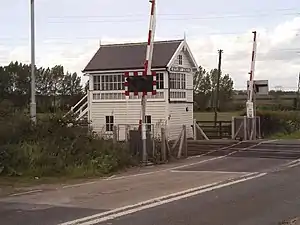 | North Lincolnshire SE9522612871 | 1885 | Built by the Railway Signal Co. of Fazakerley, Liverpool for the Manchester, Sheffield and Lincolnshire Railway.[6][7] |
| Arnside | .jpg.webp) | Cumbria SD4597578967 | 1897 | A Furness Railway Type 4 box containing a 1943 London Midland Region 35-lever frame installed in 1957.[8] |
| Askam | 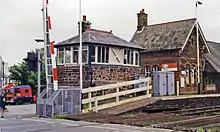 |
Cumbria SD2148277674 | 1890 | A Furness Railway Type 2 signal box.[9][10] |
| Attleborough |  | Norfolk TM0517195034 | 1883 | The signal box built for the Norfolk Railway, listed with the earlier station buildings, contains a lever frame dating from 1912.[11] |
| Aylesford |  | Kent TQ7205658680 | 1921 | The first signal box to be built by the South Eastern & Chatham Railway to a new design that was adopted by Southern Railway after grouping.[12] |
| Baschurch | 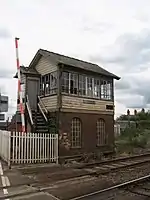 | Shropshire SJ4293222691 | 1880 | The signal box is listed with the adjacent signal. This Mackenzie and Holland type 3 box was built for the Great Western Railway and refitted in 1911.[13] |
| Beckingham |  | Nottinghamshire SK7858289819 | 1877 | A Great Northern Railway Type 1 box.[14][15] |
| Aiskew Bedale | 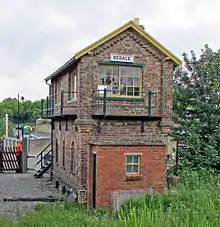 | North Yorkshire SE2685588307 | c. 1860 | Possibly designed by G.T. Andrews.[16] |
| Berwick (Sussex) |  | East Sussex TQ5262106761 | 1879 | A Saxby & Farmer Type 5 design built for the London, Brighton & South Coast Railway, containing the original Saxby & Farmer 17-lever frame.[17][18] |
| Beverley |  | East Riding of Yorkshire TA0386639525 | 1911 | A North Eastern Railway (Southern Division) Type 4 box.[19] |
| Billingshurst | .JPG.webp) | West Sussex Amberley Museum | 1876 | Built for the London, Brighton and South Coast Railway. This is the last Saxby & Farmer Type 1b box in existence, and probably was used elsewhere before it moved to Billingshurst in 1876. The 17-lever frame, however, dates from 1876. The signal box closed on 14 March 2014 and was moved to Amberley Museum just over a week later.[20][21]Note: It is not clear if the box is still listed since it was moved. English Heritage have not clarified what happens if a listed building is moved. |
| Birkdale |  | Merseyside (Sefton) SD3302915790 | 1905 | Built by the Lancashire and Yorkshire Railway, and with the original 24-lever frame.[22] |
| Birmingham New Street |  | Birmingham SP0671986672 | 1964 | Built by British Rail London Midland Region, designed by Bicknell and Hamilton with R L Moorcraft.[23] |
| Blankney (now Metheringham) |  | Lincolnshire TF0776361373 | 1928 | A Great Northern Railway Type 4 design built by the London & North Eastern Railway.[24] |
| Bollo Lane Junction (near South Acton) | 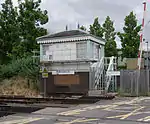 | Greater London TQ2001779017 | Probably 1878 | A London & South Western Railway Type 2 box.[25] |
| Bootle | 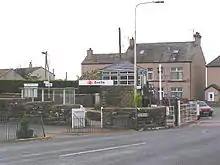 | Cumbria SD0935989318 | 1874 | A Furness Railway Type 1 design box, containing a London Midland Region 15-lever frame installed in 1977.[26] |
| Bournemouth West Junction | Dorset (Poole) SZ0635791871 | 1882 | A London & South Western Railway Type 3a design box containing a Steven’s 24-lever frame.[27] | |
| Brading |  | Isle of Wight SZ6099086886 | 1882 | Built for the Isle of Wight Railway.[28] |
| Brocklesby Junction (Near Ulceby) | .jpg.webp) | North Lincolnshire TA1189013565 | 1914 | Built by the Great Central Railway.[29][14] |
| Bromley Cross | .jpg.webp) | Lancashire SD7295513055 | 1875 | A Smith and Yardley Type 1 design built for the Lancashire and Yorkshire Railway.[30] |
| Burton Agnes | 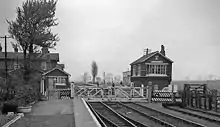 | East Riding of Yorkshire TA1078162367 | 1870/5 | A North Eastern Railway (Southern Division) S1b design box.[31][32] |
| Bury St Edmunds Yard | 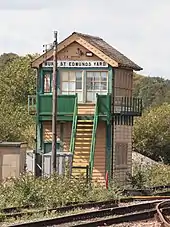 | Suffolk TL8500665180 | 1888 | A Great Eastern Railway Type 7 box containing the original McKenzie & Holland lever frame.[33] |
| Canterbury East |  | Kent TR1472457251 | c. 1911 | A South Eastern & Chatham Railway box developed from the Saxby & Farmer Type 5 design. Contains an earlier London, Chatham & Dover Railway design lever frame from c. 1878.[34][35] |
| Canterbury West |  | Kent TR1463558509 | 1928 | An early non-standard Southern Railway design.[36][37] |
| Carnforth (original) |  | Lancashire SD4969270834 | 30 January 1882 | An early Furness Railway box designed in the same style as the station.[9][38] |
| Carnforth | .jpg.webp) | Lancashire SD4960070735 | 1903 | A Furness Railway Type 4 box.[9][39] |
| Chappel and Wakes Colne |  | Essex TL8979128926 | 1891 | A Great Eastern Railway Type 7 design box, moved to the East Anglian Railway Museum.[40][41] |
| Chathill |  | Northumberland NU1864727003 | c. 1873 | A North Eastern Railway (Northern Division) Type N1 design.[42][43] |
| Chesham |  | Buckinghamshire SP9608501611 | 1889 | Built by the Metropolitan Railway.[44][45] |
| Chichester |  | West Sussex SU8559204311 | 1889 | A Saxby & Farmer Type 5 design built for the London, Brighton & South Coast Railway.[46] |
| Crawley | .jpg.webp) | West Sussex TQ2673836364 | c. 1860 | This was probably one of the earliest signal boxes with John Saxby's patented interlocking of points and signals.[47] |
| Crediton |  | Devon SX8389499502 | c. 1862 or 1875 | Probably for the London & South Western Railway; been described as a typical early (Type 1) design.[48][49] |
| Cromer |  | Norfolk TG2123242007 | 1920 | Built by William Marriott for the Midland & Great Northern Joint Railway and contains the 35-lever frame installed in 1954.[50] |
| Cross keys bridge |  | Lincolnshire River Nene TF4821721030 | 1897 | The swing bridge, originally built by A. Handyside & Co. for both road and rail, contains a signal cablin. Now only used for road. Listed Grade II*.[51] |
| Cuxton |  | Medway, Kent TQ7141966715 | possibly late 1887–9 | A South Eastern Railway box containing a South Eastern Railway 7-inch (180 mm) Brady lever frame, possibly from 1892.[52] |
| Daisyfield | 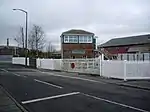 | Lancashire (Blackburn with Darwen) SD6934628770 | 1873 | A Saxby & Farmer Type 6 box built for the Lancashire & Yorkshire Railway.[53] |
| Downham Market |  | Norfolk TF6027903292 | 1881 | Great Eastern Railway type 2 with original Saxby & Farmer rocker frame.[54] |
| East Holmes |  | Lincolnshire SK9726271032 | 1873 | A Great Northern Railway Type 1 box, fitted in 1910 with a 35-lever frame by McKenzie & Holland.[55][40] |
| Eastbourne |  | East Sussex TV6120299310 | 1882 | A Saxby & Farmer Type 5 for the London, Brighton and South Coast Railway, with a 72-lever frame from 1935.[56] |
| Eastfield |  | Peterborough TL1827299881 | 1894 | A Great Northern Railway Type 1 box together with a 65-lever frame, said to have been installed in 1940.[57] |
| Ecclesfield West | Sheffield SK3633694363 | Late 19th century | A Midland Railway signal box; Minnis reported in 2012 that this had been demolished.[58][59] | |
| Elsham |  | North Lincolnshire TA0197110449 | 1885 | Built by Railway Signal Co. of Fazakerley, Liverpool for the Manchester, Sheffield & Lincolnshire Railway.[60][7] |
| Embsay |  | North Yorkshire SE0078753266 | c. 1923 | A Midland Railway Type 4D box, built by the London, Midland and Scottish Railway, containing a Midland Railway 20-lever frame.[61][62] |
| Falsgrave (Scarborough) |  | North Yorkshire TA0368287943 | 1908 | A North Eastern Railway (Southern Division) Type 4 box with original 120-lever frame.[63] |
| Feock (near Perranwell) | Cornwall SW7909239496 | c. 1854 | English Heritage entry states that this was built for the Chacewater Railway, but Minnis reports that it was not a signal box.[58][64] | |
| Garsdale |  | Cumbria SD7888291835 | 1910 | A Midland Railway Type 4c box built on the Settle to Carlisle Line; this was the location of the 1910 Hawes Junction train collision.[65] |
| Gorse Hill Bridges | Wiltshire SU1095389764 | c. 1870 | Built by Saxby & Farmer for the Broad Gauge Great Western Railway near Swindon. English Heritage entry states that it was subsequently moved and gives its location as that of the heritage Blunsdon railway station, but Minnis reported in 2012 that it no longer exists.[58][66] | |
| Goole Swing Bridge |  | East Riding of Yorkshire River Ouse SE7649924707 | 1869 | The swing bridge houses a signal cabin, and was designed by Thomas Elliot Harrison for the North Eastern Railway Listed Grade II*.[67] |
| Grain Crossing (Isle of Grain) |  | Medway, Kent TQ8631375286 | 1882 | An early, largely unaltered, Stevens & Sons signal box built for the South Eastern Railway. Contains a South Eastern Railway 9-lever frame and cast iron token machine.[68][69] |
| Hale | 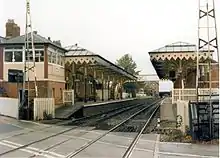 | Greater Manchester (Trafford) SJ7697486907 | 1862 and 1880s | A box built for the Cheshire Lines Committee.[70] |
| Haltwhistle |  | Northumberland NY7049463800 | Late 19th century | A non-standard North Eastern Railway box.[71][72] |
| Hammerton railway station signal cabin |  | North Yorkshire SE4701655829 | 1914 | Built by the North Eastern Railway (Southern Division), this is a large cupboard on the station platform containing a 10-lever McKenzie & Holland frame.[73] |
| Haslemere |  | Surrey SU8974332916 | 1895 | A London & South Western Railway Type 4 design containing the original 47-lever Stevens (Railway Signalling Co.) lever-frame with associated block instruments.[74] |
| Havant |  | Hampshire SU7204806564 | c. 1890 | A large Saxby & Farmer Type 5 built for the London, Brighton & South Coast Railway. The box was extended and refitted c. 1938 with a Westinghouse 70-lever frame.[75] |
| Hebden Bridge | .jpg.webp) | West Yorkshire (Calderdale) SD9957226758 | 1891 | A Lancashire & Yorkshire Railway box containing its original L&YR 36-lever frame, together with two levers added later. There is also a L&YR three-position Absolute Block Instrument and Block Bell.[76] |
| Heckington | 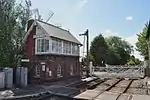 | Lincolnshire TF1459743575 | 1876 | A Great Northern Railway Type 1 built by Joseph Locke, with a Saxby & Farmer lever frame from 1925.[77][14] |
| Heighington | 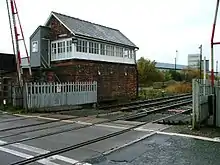 | County Durham NZ2711122536 | 1872 | Possibly built by Thomas Prosser for the North Eastern Railway (Central Division). The lever frame dates from 1906 and the box was extended c. 1912.[78] |
| Helsby Junction | 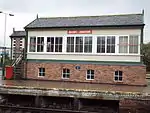 | Cheshire West and Chester SJ4868575656 | 1900 | A London & North Western Railway Type 4 box, with its original lever frame.[79] |
| Hensall |  | North Yorkshire SE5852022803 | 1875 | Built by E. S. Yardley & Co for the Lancashire & Yorkshire Railway; refitted in 1964 with a reconditioned McKenzie & Holland 10-lever frame.[80] |
| Hertford East |  | Hertfordshire TL3322713021 | 1888 | A Great Eastern Railway 1880s standard design, frame was expanded to take 45 levers in the 1930s.[81] |
| Hexham | 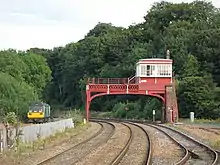 | Northumberland NY9425264187 | 1897 | A North Eastern Railway (Northern Division) Type 5 on a bridge over the railway.[42][82] |
| High Street (Lincoln) |  | Lincolnshire SK9746770942 | 1874 | A Great Northern Railway Type 1, retaining the 36-lever frame of 1892. Extended in 1925.[83][14] |
| Holmwood |  | Surrey TQ1741943737 | c. 1876 | A Saxby & Farmer Type 5 for the London, Brighton & South Coast Railway. Contains the original lever frame, W. R. Sykes block instruments, signal and track circuit repeaters.[84] |
| Horsham |  | West Sussex TQ1801231288 | 1938 | A British Railways Southern Region International Modern Style type 13.[85][86] |
| Horsted Keynes South |  | West Sussex TQ3708729183 | c. 1882 | London, Brighton & South Coast Railway Type 1, probably designed by T. H. Myres to complement the branch line stations.[87][88] |
| Howden |  | East Riding of Yorkshire SE7522430415 | 1873 | A North Eastern Railway (Southern Division) type 1A.[89] |
| Instow |  | Devon SS4736130117 | 1861 or 1874 | Built by the Bideford Extension Railway (later London & South Western Railway) to the London & South Western Railway Type 1 design.[90][49] |
| Isfield | 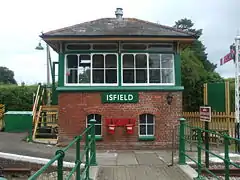 | East Sussex TQ4519917080 | c. 1880 | Built by Saxby & Farmer for the London, Brighton & South Coast Railway.[91] |
| Kettering |  | Derbyshire (Midland Railway – Butterley) | c. 1865 | A Midland Railway signal box rebuilt in 1985−6 at Swanwick Junction railway station, Midland Railway – Butterley.[4][92] |
| Keighley Station Junction |  | West Yorkshire (Bradford) SE0644441413 | 1884 | A Midland Railway Type 2a signal box.[93] |
| Kilby Bridge | .jpg.webp) | Derbyshire (Midland Railway – Butterley) SK3983651926 | c. 1865 | A Midland Railway signal box, rebuilt 1986–9 for use at Hammersmith, Midland Railway – Butterley[4][94] |
| Kirkham Abbey |  | North Yorkshire SE7331065731 | c. 1856 | English Heritage listing says this was probably designed by G. T. Andrews for the York & North Midland Railway. Alternatively, Minnis gives a date of c. 1873 and lists this as a Great Northern Railway (Southern Division) Type S1b box.[31][95] |
| Kirton Lime Sidings Hibaldstow |  | North Lincolnshire SE9504201386 | 1886 | Built by the Railway Signal Co. for the Manchester, Sheffield & Lincolnshire Railway.[96][97] |
| Knaresborough |  | North Yorkshire SE3477457103 | 1872 | A non-standard North Eastern Railway design. The upper-floor was rebuilt, probably in 1890.[98][71] |
| Leek Brook Junction | 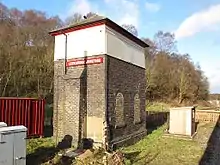 | Staffordshire SJ9811853759 | late 1860s | Built by McKenzie & Holland for the North Staffordshire Railway. The 40-lever McKenzie & Holland No. 6 frame was installed in 1903, when the line to the east opened.[99] |
| Littlehampton |  | West Sussex TQ0228702302 | 1886 | A London, Brighton & South Coast Railway Type 2 box. The LB&SCR Bosham pattern 44-lever frame was installed in 1901.[100] |
| Liverpool Street (Circle line) |  | Greater London TQ3306681579 | 1875 | Built by McKenzie & Holland for the Metropolitan Railway. The 15-lever Westinghouse and Saxby frame and control panel were installed in 1954.[101] |
| London Road, Boston |  | Lincolnshire River Witham TF3264243066 | 1884 | A signal box protecting a swing bridge containing a Saxby & Farmer 12-lever frame.[102] |
| Lostwithiel | 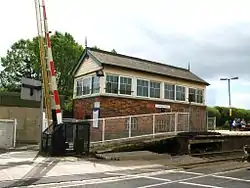 | Cornwall SX1068759798 | 1893 | A Great Western Railway type 5 box, containing a 63-lever frame installed in 1923.[103] |
| Loughborough North |  | Leicestershire (Great Central Railway) SK5432319704 | 1898 | A Great Central Railway Type 4 box.[14][104] |
| Louth North |  | Lincolnshire TF3323488134 | 1886 | A Great Northern Railway type GNR1 (East Lincolnshire).[105] |
| Maidstone West |  | Kent TQ7554055120 | 4 June 1899 | An Evans, O'Donnell & Company standard design box built for the South Eastern and Chatham Railway. Contains the original 115-lever frame and block instruments by Evans, O'Donnell & Company.[106] |
| March East Junction |  | Cambridgeshire TL4198397821 | 1885 | Built by Saxby & Farmer, a Great Eastern Railway Type 5 with a lever frame from 1897.[107] |
| Marsh Brook |  | Shropshire SO4419789866 | 1872 | London and North Western/Great Western Railway Type 1, built for the Shrewsbury and Hereford Joint Railway.[108] |
| Marston Moor | %252C_Yorkshire%252C_from_geograph_3272598_by_NigelThompson.jpg.webp) | North Yorkshire SE5110354562 | 1910 | Built by the North Eastern Railway (Southern Division) and contains six levers of a 16-lever 1873 pattern McKenzie & Holland frame.[109] |
| Monk's Siding | .jpg.webp) | Lancashire (Warrington) SJ5918387712 | 1875 | London & North Western Railway Type 3 design with theoriginal lever frame.[110] |
| Nafferton | East Riding of Yorkshire TA0585158435 | 1906 | A North Eastern Railway signal box; in 2012 Minnis reported that it had been demolished.[58][111] | |
| New Bridge | .jpg.webp) | North Yorkshire Moors Railway SE8028485386 | 1876 | North Eastern Railway (Southern Division) Type S1a.[31][112] |
| Norham | Northumberland NT9066846775 | 1911 | Built by the North Eastern Railway reusing an earlier first floor system. The railway station closed in 1965 and sold, but was preserved and open to the public until 2010.[113][114][115] | |
| Norton East |  | County Durham NZ4318622496 | 1870 | Built by the North Eastern Railway (Central Division) orientated gable-end to the tracks and with a glazed side extension to the operating floor, the box is fitted with a 25-lever frame from 1959.[116] |
| Nunthorpe |  | North Yorkshire (Redcar and Cleveland) NZ5387015025 | 1903 | Built by the North Eastern Railway (Central Division) to its type C2b design, this box contains a reconditioned McKenzie & Holland 16-lever frame and a wheel for opening the level crossing gates.[117] |
| Oakham |  | Rutland SK8568008922 | 1899 or 1901 | A Midland Railway type 2B box.[118][119] |
| Oswestry South | Shropshire SJ2936629707 | 1882 | Built by Dutton & Co. for the Cambrian Railways with a porch characteristic of the contractor's signal boxes.[7][120] | |
| Par | 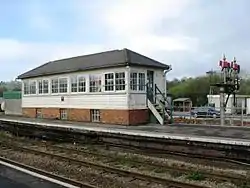 | Cornwall SX0769054062 | c. 1879 | A Great Western Railway type 2 box.[121] |
| Parbold |  | Lancashire SD4911310736 | 1877 | A Saxby & Farmer Type 9 box built for the Lancashire and Yorkshire Railway; the frame dates from 1983.[122] |
| Petersfield |  | Hampshire SU7440923616 | c. 1885 | London & South Western Railway Type 3a box containing a 10-lever Stevens (Railway Signalling Co.) frame and locking rack from about 1880, with block instruments, and a track diagram from 1974.[123] |
| Plumpton | .jpg.webp) | East Sussex TQ3651616091 | 1891 | A London, Brighton & South Coast Railway Type 2 box, built at about the same time as the railway station.[124][87] |
| Princes Risborough North | 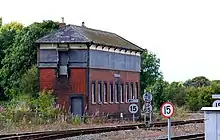 | Buckinghamshire SP7993202966 | 1908 | A "Churchward" era Great Western Railway Type 7 design.[125][126] |
| Pulborough |  | West Sussex TQ0435318732 | 1878 | Saxby & Farmer Type 5 design box built for the London, Brighton & South Coast Railway (LB&SCR), with a 1905-pattern LB&SCR 29-lever frame with 25 levers.[127] |
| Ruislip | _(crop).jpg.webp) | Greater London TQ0951187027 | 1904 | A Metropolitan Railway design signal box built by the Harrow and Uxbridge Railway; worked by the Metropolitan Railway from 1905.[128][45] |
| Runcorn | .jpg.webp) | Cheshire (Halton) SJ5090682522 | 1940 | Built by the London, Midland and Scottish Railway in a Modernist style, this was one of the signal boxes designed to minimise the blast damage from aerial bombing during World War II. Contains the original 46-lever frame.[129] |
| Rye |  | East Sussex TQ9187920553 | 1894 | A Saxby & Farmer Type 12 box for the South Eastern Railway, containing an earlier original 1888 Duplex frame with 14 levers.[130] |
| Sandford |  | North Somerset ST4162259541 | 1869 | A block house, which housed early signalling equipment. Designed by Frances Fox for the Bristol & Exeter Railway.[131] |
| Selside | Lancashire (Carnforth Steamtown) SD4963470815 | 1907 | Built by the Midland Railway for Selside on the Settle to Carlisle Line, the box was moved in 1976 to Carnforth Steamtown, which has since closed to the public.[132][133][118] | |
| Settle |  | North Yorkshire SD8170863421 | 1891 | Standard Midland Railway Type 2a design box with the original 20-lever frame and interlocking mechanism, moved and restored 1997–9.[134][118] |
| Shepherds Well | 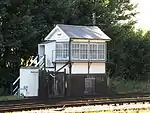 | Kent TR2574248275 | c. 1878 | A London, Chatham & Dover Railway signal box with original 23-lever frame.[135] |
| Shildon |  | County Durham NZ2366825688 | 1887 | A variant of the North Eastern Railway Central Division's Type C2, possibly designed by the Thomas Prosser. A McKenzie & Holland 16-lever frame dates from 1928, although reduced from 55 to 42 levers in 1984.[136] |
| Shrewsbury Crewe Junction |  | Shropshire SJ4936013060 | 1902–3 | An atypical London & North Western Railway type 4 box for the London and North Western and Great Western Railway Joint Committee.[137][138] |
| Shrewsbury Severn Bridge Junction |  | Shropshire SJ4969712678 | 1903 | An atypical London & North Western Railway type 4 box for the London and North Western and Great Western Railway Joint Committee, containing an LNWR 180-lever frame.[139][138] |
| Skegness |  | Lincolnshire TF5602563051 | 1882 | A timber framed Great Northern Railway Type 1 box, enlarged in 1900, still containing its lever frame.[140][14] |
| Sleaford East |  | Lincolnshire TF0687845398 | c. 1882 | A Great Northern Railway Type 1, built for the Great Northern and Great Eastern Joint Railway.[141][14] |
| Snodland |  | Kent TQ7067461795 | 1870s | Built by the South Eastern Railway, later extended to ease operation of the level crossing gates.[142][143] |
| St Albans South |  | Hertfordshire TL1553106891 | 1892 | A large three bay Midland Railway design box.[144][118] |
| St Bees | 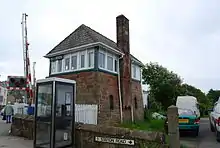 | Cumbria NX9702911989 | 1891 | The Furness Railway Type 3 box was designed in arts and crafts style to complement the stations. This one contains its original Railway Signal Company 24-lever frame.[145][146] |
| St Mary's Crossing | 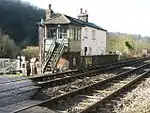 | Gloucestershire SO8859102237 | c. 1875 | A Great Western Railway Type 2 box.[147][148] |
| Stoke Canon | .jpg.webp) | Devon SX9368297998 | c. 1874 | Built by Saxby & Farmer for the Bristol & Exeter Railway.[149] |
| Stow Park |  | Lincolnshire SK8566181465 | 1877 | A Great Northern Railway Type 1 box.[150][14] |
| Sudbury |  | Staffordshire SK1625330662 | 1885 | Built by the North Staffordshire Railway from a design derived from the McKenzie & Holland type 1 box. Contains the original 24-lever frame and wheel to control the level crossing gates.[151] |
| Swinderby |  | Lincolnshire SK8684664379 | 1901 | A Midland Railway signal box, containing the original lever frame.[152][118] |
| Thetford |  | Norfolk TL8672483687 | 1883 | A Great Eastern Railway Type 4 box with the original McKenzie & Holland lever frame.[153] |
| Topsham |  | Devon SX9664888408 | c. 1870 | A modified London and South Western Railway type 1 design.[154] |
| Torquay | 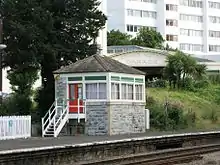 | Devon (Torbay) SX9058363397 | 1878 | This signal box was built by the Great Western Railway at the same time as the station.[155] |
| Torre | 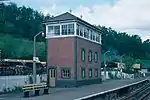 | Devon (Torbay) SX9033264843 | 1921–22 | A Great Western Railway type 7 box with its original lever frame.[156] |
| Totnes | 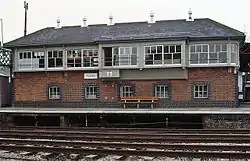 | Devon SX8017960959 | 1923 | A Great Western Railway type 7 box.[157] |
| Tutbury Crossing |  | South Derbyshire SK2149929677 | 1872 | A McKenzie & Holland Type 1 box for the North Staffordshire Railway, containing a McKenzie & Holland 5 inches (130 mm) lever frame installed in 1897.[158] |
| Wainfleet | 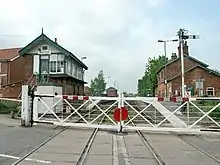 | Lincolnshire TF4970858749 | 1899 | A later Great Northern Railway box, with a Railway Signal Co. lever frame.[159][14] |
| Wansford |  | Cambridgeshire TL0932497972 | 1907 | London & North Western Railway Type 5 box.[160][161] |
| Warmley | _disused_signal_box_-_geograph.org.uk_-_673692.jpg.webp) | South Gloucestershire ST6712673504 | 1918 | A Midland Railway type 4D box with a pre-1943 LMS 16-lever frame.[162] |
| Wateringbury |  | Kent TQ6906252788 | 1893 | A Saxby & Farmer Type 12 for built the South Eastern Railway.[163] |
| Weaverthorpe |  | North Yorkshire SE9568078149 | c. 1900 | Built for the North Eastern Railway.[164] |
| Wellow |  | Bath and North East Somerset ST7402358186 | 1892 | A Somerset and Dorset Joint Railway Type 2 box. After closure in 1962 the box was converted into an artist's studio for Peter Blake, and has since being expanded and adapted into living accommodation.[165] |
| West Street Junction (Boston) |  | Lincolnshire TF3223643948 | 1875 | A Great Northern Railway Type 1 box, with a 60-lever McKenzie & Holland frame dating from 1894.[166][14] |
| Weston-super-Mare | 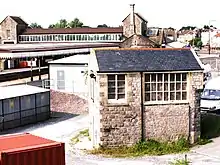 | North Somerset ST3246661108 | c. 1866 | Built for the Bristol and Exeter Railway, this is possibly the oldest surviving signal box on the British rail system.[167] |
| Williton |  | Somerset ST0856241534 | 1862 | An early Bristol and Exeter Railway signal box, containing the original lever frame.[168][148] |
| Woking | .jpg.webp) | Surrey TQ0056858644 | 1937 | A British Railways Southern Region International Modern Style box.[85][169] |
| Wolferton |  | Norfolk TF6600028507 | 1862 | A non-standard Great Eastern Railway Type 5, designed to complement the royal station. Moved 1898–99 to allow line to be widened. Listed as Grade II*.[170][40] |
| Woolston |  | Southampton SU4393111240 | 1901 | A London & South Western Railway Type 4 box.[171] |
| Worksop East |  | Nottinghamshire SK5866679726 | c. 1880–c. 1885 | Built by the Manchester, Sheffield & Lincolnshire Railway.[172][14] |
| Wrawby Junction (near Barnetby railway station) |  | North Lincolnshire TA0468609316 | 7 May 1916 | Built by the Great Central Railway with 132 levers, 5 levers were added later.[173] |
| Wroxham |  | Norfolk TG3031218644 | 1900 | A Great Eastern Railway Type 7 box, probably built by McKenzie & Holland, housing a McKenzie and Holland 50-lever frame of the same age. Has been moved slightly away from the tracks.[40][174] |
| Wylam |  | Northumberland NZ1196264484 | 1897 | A North Eastern Railway (Northern Division) Type 5 on a bridge over the railway.[42][175] |
| Wymondham South Junction |  | Norfolk TG1132200889 | 1877 | A Great Eastern Railway Type 2 box, with a McKenzie & Holland 42-lever frame of unknown date.[176] |
| York railway station (Platform) |  | York SE5959751712 | 1900–09 | The wooden signal box above the bookshop on the platform is listed with the Grade II* railway station.[177] |
| York railway station (1951) |  | York SE5959751712 | 1951 | The orange brick signal box built on the western side is listed with the Grade II* railway station.[177] |
Notes and references
References
- Minnis 2012, p. 1.
- "Protecting, conserving and providing access to the historic environment in England". Department for Digital, Culture, Media and Sport. 27 February 2013. Retrieved 7 May 2013.
- "England's Railway signalling Heritage Recognised" (Press release). English Heritage. 26 July 2013.
- "Operational signal boxes". Midland Railway – Butterley. Retrieved 28 August 2013.
- Historic England. "Details from listed building database (1335401)". National Heritage List for England. Retrieved 28 August 2013.
- Historic England. "Details from listed building database (1161513)". National Heritage List for England. Retrieved 28 August 2013.
- Minnis 2012, p. 7.
- Historic England. "Details from listed building database (1412051)". National Heritage List for England. Retrieved 13 September 2013.
- Minnis 2012, p. 22.
- Historic England. "Details from listed building database (1197891)". National Heritage List for England. Retrieved 28 August 2013.
- Historic England. "Details from listed building database (1401582)". National Heritage List for England. Retrieved 28 August 2013.
- Historic England. "Details from listed building database (1415110)". National Heritage List for England. Retrieved 28 August 2013.
- Historic England. "Details from listed building database (1386582)". National Heritage List for England. Retrieved 28 August 2013.
- Minnis 2012, p. 32.
- Historic England. "Details from listed building database (1045091)". National Heritage List for England. Retrieved 28 August 2013.
- Historic England. "Details from listed building database (1252652)". National Heritage List for England. Retrieved 28 August 2013.
- Historic England. "Details from listed building database (1413793)". National Heritage List for England. Retrieved 1 September 2014.
- Minnis 2012, pp. 9–10.
- Historic England. "Details from listed building database (1084065)". National Heritage List for England. Retrieved 28 August 2013.
- Henderson, Maggie (January 2014). Historic Building Record: Billingshurst signal box (PDF) (Report). Maggie Henderson and Network Rail. pp. 2–4. Archived (PDF) from the original on 21 September 2014.
Historic England. "Details from listed building database (1271531)". National Heritage List for England. Retrieved 28 August 2013. - "Signal box moves home as part of £21m investment in Arun Valley line" (Press release). Network Rail. 24 March 2014. Archived from the original on 21 September 2014.
"VIDEO: Billingshurst signal box to take pride of place in Amberley Museum". West Sussex Gazette. Archived from the original on 21 September 2014. - Historic England. "Details from listed building database (1412052)". National Heritage List for England. Retrieved 1 June 2014.
- Historic England. "Details from listed building database (1117383)". National Heritage List for England. Retrieved 28 August 2013.
- Historic England. "Details from listed building database (1413991)". National Heritage List for England. Retrieved 14 September 2014.
- Historic England. "Details from listed building database (1323687)". National Heritage List for England. Retrieved 28 August 2013.
- Historic England. "Details from listed building database (1412053)". National Heritage List for England. Retrieved 14 September 2014.
- Historic England. "Details from listed building database (1413713)". National Heritage List for England. Retrieved 28 August 2013.
- Historic England. "Details from listed building database (1034364)". National Heritage List for England. Retrieved 28 August 2013.
- Historic England. "Details from listed building database (1249630)". National Heritage List for England. Retrieved 28 August 2013.
- Historic England. "Bromley Cross Railway Station (inc. signal box and low level platform) (1422397)". National Heritage List for England. Retrieved 28 July 2015.
- Minnis 2012, p. 34.
- Historic England. "Details from listed building database (1420282)". National Heritage List for England. Retrieved 16 September 2014.
- Historic England. "Details from listed building database (1414231)". National Heritage List for England. Retrieved 28 August 2013.
- Minnis 2012, p. 17.
- Historic England. "Details from listed building database (1413579)". National Heritage List for England. Retrieved 28 August 2013.
- Minnis 2012, p. 43.
- Historic England. "Details from listed building database (1258154)". National Heritage List for England. Retrieved 28 August 2013.
- Historic England. "Details from listed building database (1071920)". National Heritage List for England. Retrieved 28 August 2013.
- Historic England. "Details from listed building database (1078212)". National Heritage List for England. Retrieved 28 August 2013.
- Minnis 2012, p. 31.
- Historic England. "Details from listed building database (1225566)". National Heritage List for England. Retrieved 28 August 2013.
- Minnis 2012, p. 36.
- Historic England. "Details from listed building database (1276364)". National Heritage List for England. Retrieved 28 August 2013.
- Historic England. "Details from listed building database (1401704)". National Heritage List for England. Retrieved 28 August 2013.
- Minnis 2012, p. 42.
- Historic England. "Details from listed building database (1413573)". National Heritage List for England. Retrieved 14 September 2014.
- Historic England. "Details from listed building database (1298887)". National Heritage List for England. Retrieved 28 August 2013.
- Historic England. "Details from listed building database (1292537)". National Heritage List for England. Retrieved 28 August 2013.
- Minnis 2012, p. 20.
- Historic England. "Details from listed building database (1380342)". National Heritage List for England. Retrieved 28 August 2013.
- Historic England. "Details from listed building database (1064536)". National Heritage List for England. Retrieved 28 August 2013.
- Historic England. "Details from listed building database (1413571)". National Heritage List for England. Retrieved 28 August 2013.
- Historic England. "Details from listed building database (1412054)". National Heritage List for England. Retrieved 14 September 2014.
- Historic England. "Details from listed building database (1414022)". National Heritage List for England. Retrieved 28 August 2013.
- Historic England. "Details from listed building database (1391954)". National Heritage List for England. Retrieved 28 August 2013.
- Historic England. "Details from listed building database (1413815)". National Heritage List for England. Retrieved 28 August 2013.
- Historic England. "Details from listed building database (1119749)". National Heritage List for England. Retrieved 28 August 2013.
- Minnis 2012, p. 51.
- Historic England. "Details from listed building database (1240614)". National Heritage List for England. Retrieved 28 August 2013.
- Historic England. "Details from listed building database (1346846)". National Heritage List for England. Retrieved 28 August 2013.
- Historic England. "Details from listed building database (1301523)". National Heritage List for England. Retrieved 28 August 2013.
- "Signalling". Embsay and Bolton Abbey Steam Railway. Retrieved 26 September 2014.
- Historic England. "Details from listed building database (1243660)". National Heritage List for England. Retrieved 28 August 2013.
- Historic England. "Details from listed building database (1329007)". National Heritage List for England. Retrieved 28 August 2013.
- Historic England. "Details from listed building database (1412055)". National Heritage List for England. Retrieved 14 September 2014.
- Historic England. "Details from listed building database (1023159)". National Heritage List for England. Retrieved 28 August 2013.
- Historic England. "Details from listed building database (1346710)". National Heritage List for England. Retrieved 28 August 2013.
- Minnis 2012, p. 14.
- Historic England. "Details from listed building database (1415162)". National Heritage List for England. Retrieved 28 August 2013.
- Historic England. "Details from listed building database (1356499)". National Heritage List for England. Retrieved 28 August 2013.
- Minnis 2012, pp. 36–37.
- Historic England. "Details from listed building database (1156313)". National Heritage List for England. Retrieved 28 August 2013.
- Historic England. "Details from listed building database (1416398)". National Heritage List for England. Retrieved 15 September 2015.
- Historic England. "Details from listed building database (1415807)". National Heritage List for England. Retrieved 14 September 2014.
- Historic England. "Details from listed building database (1271846)". National Heritage List for England. Retrieved 28 August 2013.
- Historic England. "Details from listed building database (1412056)". National Heritage List for England. Retrieved 28 August 2013.
- Historic England. "Details from listed building database (1061808)". National Heritage List for England. Retrieved 28 August 2013.
- Historic England. "Details from listed building database (1391940)". National Heritage List for England. Retrieved 28 August 2013.
- Historic England. "Details from listed building database (1412057)". National Heritage List for England. Retrieved 28 August 2013.
- Historic England. "Details from listed building database (1412058)". National Heritage List for England. Retrieved 28 August 2013.
- Historic England. "Details from listed building database (1268761)". National Heritage List for England. Retrieved 28 August 2013.
- Historic England. "Details from listed building database (1042523)". National Heritage List for England. Retrieved 28 August 2013.
- Historic England. "Details from listed building database (1392292)". National Heritage List for England. Retrieved 28 August 2013.
- Historic England. "Details from listed building database (1376781)". National Heritage List for England. Retrieved 28 August 2013.
- Minnis 2012, p. 41.
- Historic England. "Details from listed building database (1390051)". National Heritage List for England. Retrieved 28 August 2013.
- Minnis 2012, p. 19.
- Historic England. "Details from listed building database (1257907)". National Heritage List for England. Retrieved 28 August 2013.
- Historic England. "Details from listed building database (1233349)". National Heritage List for England. Retrieved 28 August 2013.
- Historic England. "Details from listed building database (1107599)". National Heritage List for England. Retrieved 28 August 2013.
- Historic England. "Details from listed building database (1392068)". National Heritage List for England. Retrieved 28 August 2013.
- Historic England. "Details from listed building database (1051649)". National Heritage List for England. Retrieved 28 August 2013.
- Historic England. "Details from listed building database (1134151)". National Heritage List for England. Retrieved 28 August 2013.
- Historic England. "Details from listed building database (1329374)". National Heritage List for England. Retrieved 28 August 2013.
- Historic England. "Details from listed building database (1315766)". National Heritage List for England. Retrieved 28 August 2013.
- Minnis 2012, p. 12.
- Historic England. "Details from listed building database (1260906)". National Heritage List for England. Retrieved 28 August 2013.
- Historic England. "Details from listed building database (1248970)". National Heritage List for England. Retrieved 28 August 2013.
- Historic England. "Details from listed building database (1392398)". National Heritage List for England. Retrieved 28 August 2013.
- Historic England. "Details from listed building database (1413574)". National Heritage List for England. Retrieved 28 August 2013.
- Historic England. "Details from listed building database (1413844)". National Heritage List for England. Retrieved 28 August 2013.
- Historic England. "Details from listed building database (1388922)". National Heritage List for England. Retrieved 28 August 2013.
- Historic England. "Details from listed building database (1413727)". National Heritage List for England. Retrieved 28 August 2013.
- Historic England. "Details from listed building database (1391315)". National Heritage List for England. Retrieved 28 August 2013.
- Historic England. "Details from listed building database (1389137)". National Heritage List for England. Retrieved 28 August 2013.
- Historic England. "Details from listed building database (1415105)". National Heritage List for England. Retrieved 28 August 2013.
- Historic England. "Details from listed building database (1408197)". National Heritage List for England. Retrieved 28 August 2013.
- Historic England. "Details from listed building database (1412942)". National Heritage List for England. Retrieved 28 August 2013.
- Historic England. "Details from listed building database (1412060)". National Heritage List for England. Retrieved 14 September 2014.
- Historic England. "Details from listed building database (1412064)". National Heritage List for England. Retrieved 15 September 2014.
- Historic England. "Details from listed building database (1346310)". National Heritage List for England. Retrieved 16 September 2014.
- Historic England. "Details from listed building database (1241471)". National Heritage List for England. Retrieved 28 August 2013.
- Daniel, Brian (19 October 2013). "Norham railway station near Berwick is put up for sale". The Journal. Retrieved 17 September 2014.
- "Northam Station for sale" (PDF). Sale & Partners. Archived (PDF) from the original on 18 September 2014.
- Historic England. "Details from listed building database (1155048)". National Heritage List for England. Retrieved 28 August 2013.
- Historic England. "Details from listed building database (1412065)". National Heritage List for England. Retrieved 14 September 2014.
- Historic England. "Details from listed building database (1412066)". National Heritage List for England. Retrieved 14 September 2014.
- Minnis 2012, p. 28.
- Historic England. "Details from listed building database (1252769)". National Heritage List for England. Retrieved 28 August 2013.
- Historic England. "Details from listed building database (1176559)". National Heritage List for England. Retrieved 28 August 2013.
- Historic England. "Details from listed building database (1413731)". National Heritage List for England. Retrieved 28 August 2013.
- Historic England. "Details from listed building database (1361805)". National Heritage List for England. Retrieved 28 August 2013.
- Historic England. "Details from listed building database (1415912)". National Heritage List for England. Retrieved 14 September 2014.
- Historic England. "Details from listed building database (1238580)". National Heritage List for England. Retrieved 28 August 2013.
- Historic England. "Details from listed building database (1276408)". National Heritage List for England. Retrieved 28 August 2013.
- Minnis 2012, p. 39.
- Historic England. "Details from listed building database (1413381)". National Heritage List for England. Retrieved 15 September 2014.
- Historic England. "Details from listed building database (1380983)". National Heritage List for England. Retrieved 28 August 2013.
- Historic England. "Details from listed building database (1412067)". National Heritage List for England. Retrieved 10 December 2013.
- Historic England. "Details from listed building database (1415163)". National Heritage List for England. Retrieved 28 August 2013.
- Historic England. "Details from listed building database (1312615)". National Heritage List for England. Retrieved 2 October 2014.
- Historic England. "Details from listed building database (1078214)". National Heritage List for England. Retrieved 28 August 2013.
- "Selside Signal Box relocated to "Carnforth Steam Town"". Friends of the Settle-Carlisle Line. 1 March 2013. Retrieved 14 September 2014.
For photos see "Carnforth Open Day 2008: Selside signalbox". Ukrailways1970tilltoday. Retrieved 14 September 2014. - Historic England. "Details from listed building database (1412069)". National Heritage List for England. Retrieved 15 September 2014.
- Historic England. "Details from listed building database (1413576)". National Heritage List for England. Retrieved 28 August 2013.
- Historic England. "Details from listed building database (1390827)". National Heritage List for England. Retrieved 28 August 2013.
- Historic England. "Details from listed building database (1247161)". National Heritage List for England. Retrieved 28 August 2013.
- Minnis 2012, pp. 26–27.
- Historic England. "Details from listed building database (1271480)". National Heritage List for England. Retrieved 28 August 2013.
- Historic England. "Details from listed building database (1413516)". National Heritage List for England. Retrieved 28 August 2013.
- Historic England. "Details from listed building database (1261326)". National Heritage List for England. Retrieved 28 August 2013.
- Historic England. "Details from listed building database (1413577)". National Heritage List for England. Retrieved 28 August 2013.
- Minnis 2012, p. 16.
- Historic England. "Details from listed building database (1103005)". National Heritage List for England. Retrieved 28 August 2013.
- Historic England. "Details from listed building database (1412068)". National Heritage List for England. Retrieved 15 September 2014.
- Minnis 2012, p. 23.
- Historic England. "Details from listed building database (1340480)". National Heritage List for England. Retrieved 28 August 2013.
- Minnis 2012, p. 38.
- Historic England. "Details from listed building database (1262013)". National Heritage List for England. Retrieved 28 August 2013.
- Historic England. "Details from listed building database (1146606)". National Heritage List for England. Retrieved 28 August 2013.
- Historic England. "Details from listed building database (1038322)". National Heritage List for England. Retrieved 28 August 2013.
- Historic England. "Details from listed building database (1165196)". National Heritage List for England. Retrieved 28 August 2013.
- Historic England. "Details from listed building database (1414027)". National Heritage List for England. Retrieved 28 August 2013.
- Historic England. "Details from listed building database (1224484)". National Heritage List for England. Retrieved 28 August 2013.
- Historic England. "Details from listed building database (1218283)". National Heritage List for England. Retrieved 28 August 2013.
- Historic England. "Details from listed building database (1414397)". National Heritage List for England. Retrieved 28 August 2013.
- Historic England. "Details from listed building database (1413738)". National Heritage List for England. Retrieved 28 August 2013.
- Historic England. "Details from listed building database (1413816)". National Heritage List for England. Retrieved 3 October 2014.
- Historic England. "Details from listed building database (1414000)". National Heritage List for England. Retrieved 28 August 2013.
- Historic England. "Details from listed building database (1274859)". National Heritage List for England. Retrieved 28 August 2013.
- Minnis 2012, p. 27.
- Historic England. "Details from listed building database (1231481)". National Heritage List for England. Retrieved 28 August 2013.
- Historic England. "Details from listed building database (1414978)". National Heritage List for England. Retrieved 28 August 2013.
- Historic England. "Details from listed building database (1308300)". National Heritage List for England. Retrieved 28 August 2013.
- Historic England. "Details from listed building database (1413358)". National Heritage List for England. Retrieved 17 September 2014.
- Historic England. "Details from listed building database (1388986)". National Heritage List for England. Retrieved 28 August 2013.
- Historic England. "Details from listed building database (1129748)". National Heritage List for England. Retrieved 28 August 2013.
- Historic England. "Details from listed building database (1174890)". National Heritage List for England. Retrieved 28 August 2013.
- Historic England. "Details from listed building database (1236967)". National Heritage List for England. Retrieved 28 August 2013.
- Historic England. "Details from listed building database (1077592)". National Heritage List for England. Retrieved 28 August 2013.
- Historic England. "Details from listed building database (1413387)". National Heritage List for England. Retrieved 15 September 2014.
- Historic England. "Details from listed building database (1277083)". National Heritage List for England. Retrieved 28 August 2013.
- Historic England. "Details from listed building database (1249229)". National Heritage List for England. Retrieved 28 August 2013.
- Historic England. "Details from listed building database (1356772)". National Heritage List for England. Retrieved 28 August 2013.
- Historic England. "Details from listed building database (1155046)". National Heritage List for England. Retrieved 28 August 2013.
- Historic England. "Details from listed building database (1414469)". National Heritage List for England. Retrieved 28 August 2013.
- Historic England. "Details from listed building database (1256554)". National Heritage List for England. Retrieved 28 August 2013.
Sources
- Minnis, John (February 2012). Railway signal boxes: A Review (PDF) (Report). English Heritage. ISSN 2046-9802.
Further reading
External links
- "In pictures: Ten of the 'best' listed signal boxes". BBC News. 6 September 2012.